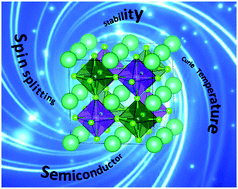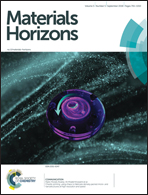A class of Pb-free double perovskite halide semiconductors with intrinsic ferromagnetism, large spin splitting and high Curie temperature†
Abstract
Room-temperature ferromagnetic (FM) semiconductors are of vital importance for realizing advanced spintronic devices. The recent discovery of diluted ferromagnetism in Mn-doped CH3NH3PbI3 suggests hopes for developing halide perovskite based spintronics. However, the measured Curie temperature was usually below 15 K, which severely prohibits the Mn-doped CH3NH3PbI3 from being applied in room-temperature applications. In this work, instead of using the usual doping strategy, we present a new class of Pb-free FM halide semiconductors with double perovskite structures (Cs2GeMX6, transition metal M = V, Mn or Ni; X = Cl, Br or I), which possess spin splitting in a broad range of 0.06–1.00 eV and ultrahigh Curie temperature of 490–800 K. Furthermore, the Curie temperature can still be higher than room temperature under the lattice expansion effect. These excellent intrinsic properties are because of the large number of nearest neighboring magnetic ions and strong exchange coupling between the M 3d and GeX6 σs–p* orbitals. Our designed Pb-free FM halide semiconductors with double perovskite structures can be envisaged to develop into other highly dynamic research fields with vast implications for high-performance spin optoelectronics and spintronics.

- This article is part of the themed collection: International Year of the Periodic Table : From Pb and Sn Perovskites to the Next Generation


 Please wait while we load your content...
Please wait while we load your content...